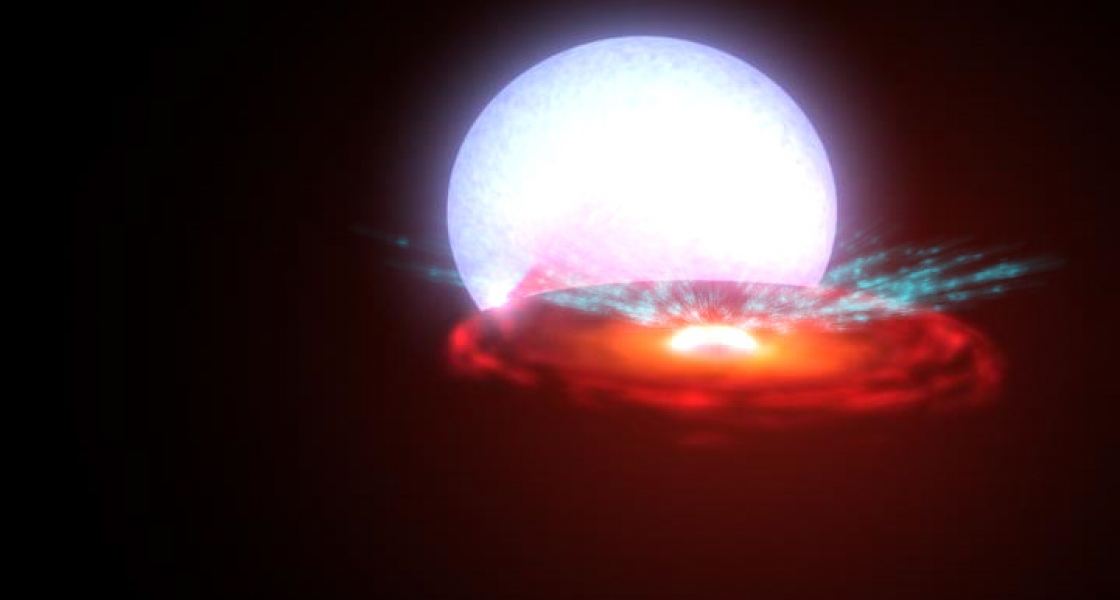Fellows Mitch Begelman and Phil Armitage have just solved the 40-year old mystery of what causes the gas of stellar debris surrounding black holes in binaries to flip back and forth cyclically between a spherical cloud and a luminous disk.
When stellar-sized black holes orbit around another star, the black holes feed themselves by pulling material off their companion stars, funneling it in close. Once near a black hole, the stellar debris exists either as (1) an extremely hot spherical cloud that isn’t very bright or (2) a thin and opaque disk of hot gas that is very luminous. Curiously, these black holes don’t stay in the same state for more than a few weeks to a few months. Rather, they flip back and forth between the two states in a systematic, but somewhat unpredictable fashion.
The strangest aspect of the switch is what happens to the luminosity. The gas will switch from being a disk to a spherical envelope around the black hole only when the luminosity is very low. With time, the luminosity increases as more and more matter from the neighboring star arrives near the black hole. However, the gas near the black hole remains in a very hot spherical state until extremely high luminosities occur. Then the gas suddenly flips into a very luminous, thin disk. Over time, the thin disk gets less and less luminous, but it doesn’t flip back to a hot sphere until it gets to a very low luminosity. The actual transition between states is quite rapid.
Through the years, many scientists have scratched their heads over this puzzling cycle, but no more, thanks to Armitage and Begelman.
They suggest that the culprit is a systematic, but random, ebb and flow of magnetic fields in the gas surrounding the black hole. The hot spherical structure favors the accumulation and growth of magnetic fields. Matter flowing toward the black hole drags magnetic fields generated near the outside of the cloud close to the black hole. Once that happens, the magnetic field cannot escape. The strong magnetic field helps the gas cloud remain hot and spherical for much longer than it would otherwise be able to do.
Then, for reasons that are still not yet well understood, the cloud suddenly flips into a disk. Once this happens, the magnetic field leaks away fairly quickly. Without a strong magnetic field, the disk state is more persistent, and doesn’t flip back to a hot cloud until the luminosity becomes very low.
So why does the magnetic field eventually return? Out beyond the disk of hot gas (and the sphere of hot gas as well), there’s always a cold disk of stellar matter that doesn’t change state. Both the hot disk and the cold disk randomly generate small magnetic fields with north and south poles that quickly cancel themselves out. However, at the border between the hot and cold disks, it’s possible for the magnetic poles to get separated and uncorrelated. And, when there are many random, uncorrelated events, there’s always some chance that something big will happen.
It turns out that if magnetic fields come and go across the border between the hot and cold disks for several months, there’s a good chance that a strong magnetic field will build up near the black hole. When this happens, the hot cloud once again becomes more robust, and the cycle repeats. Armitage and Begelman don’t yet know the details of how the hot cloud collapses to a thin disk or how the thin disk becomes a sphere. But, they now know what causes the transitions.
For decades, astronomers have observed black holes in binary systems flipping back and forth over and over again. And, now astronomers know why the observed cycles don’t repeat exactly. It’s because of the random nature of the regeneration of a magnetic field in the disk.—Julie Phillips
Reference
Mitchell C. Begelman and Philip J. Armitage, The Astrophysical Journal Letters 782, L18 (2014).




